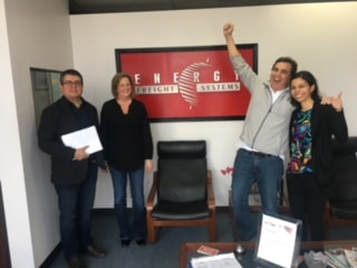|
Congratulations to Energy Freight Systems for being recommended for ISO 9001:2015 certification, as related to the provision of international transportation services, including ocean freight, air freight, inland freight, warehousing and packing and crating.
This ISO 9001:2015 certification effort included both Energy Freight Systems’ warehouse location in Houston TX, as well as their corporate headquarters in Miami FL. The resulting certification was achieved in just under 5 months. Founded in 2001, Energy Freight Systems (EFS) is a leading provider of high quality international transportation solutions and services. Learn more about their products and services at http://www.energyfreight.com/.
0 Comments
Congratulations to Zachry Engineering Corp. for being recommended for ISO 9001:2015 certification. Learn more about their products and services at https://www.zachrygroup.com.
ISO 9001 - Planning of Changes (6.3)ISO 9001:2015, clause 6.3 requires that “when the organization determines the need for changes to the quality management system, the changes shall be carried out in a planned manner (see 4.4)”.
What Does This Mean? To fully understand this requirement of ISO 9001:2015, let’s first begin with the literal definitions of the key word(s) used. Almost all of the wording used in the ISO 9001:2015 standard is purposeful, with very specific intention.
How Does This Apply? Next, let’s clarify the application of this requirement, by looking to ISO 9001:2015, clause 4.4, Quality management system and its processes. This particular clause of ISO 9001:2015 requires the organization to determine the processes needed for the quality management system, as well as their sequence and interaction, the inputs required, outputs expected, monitoring and measurement, responsibilities, resources, etc. Stated in Different Terms Finally, with both definitions and application established, let’s completely reword this requirement of ISO 9001:2015 as follows: When the organization ascertains or establishes the need to alter the form, nature, content or future course of the quality management system, its processes, required inputs or desired outputs, resources, or responsibilities, etc., the organization shall establish and organize those activities required. Practical Application This requirement of ISO 9001:2015 is intended to address those changes which may have a direct impact on Quality Management System, or the subsequent achievement of its specified outcomes. In the practical application of this requirement, we can use to the Plan-Do-Check-Act model, which is referred to throughout this standard: Plan
Do
Check
Act
Typically, when we’re talking about the planning of changes at a management systems level, we don’t consider those day-to-day changes related to contractual amendments, engineering changes, purchasing modifications, product deviations, alterations or changes to other work-specific deliverables and outputs, which would be considered a normal part of operations and more appropriately, covered under other requirements. Is documented information required for the planning of changes? Typically, when the words “determined” and “planned” are used in ISO 9001:2015, I’d consider this to be implied. Without objective evidence being retained, there’s no proof that any of the above has actually occurred. Note also, that not all alterations, modifications or adjustments to a management system require the planning of change. Examples of this could include changing line employees, replacing worn equipment, replenishing inventory, editorial revisions to documents, etc. In most cases, these types of changes can be considered substitutions. The intent of the change process should not be to prevent anyone from taking immediate steps to protect the health and safety of employees, the environment, company or customer property, etc. during an emergency or unplanned event. However, any changes made under such circumstances should be immediately followed up with an appropriate evaluation once the emergency situation has been resolved. Scope statement examples for ISO 9001:2015 ISO 9001:2015 requires an organization to determine the boundaries and applicability of its quality management system (QMS). This determination lays the framework for establishing the organization’s scope, which is then required by ISO 9001 to be maintained as documented information.
When determine an organization’s scope, ISO 9001:2015 (4.3) requires that consideration must be given to: 1. the internal and external factors referred to in 4.1; 2. the requirements of relevant interested parties referred to in 4.2; 3. the Products and Services of the organization. What does this mean? The following are a few examples of scope statements, in this case detailing a fictitious company (XYZ) that provides machine shop services. While the XYZ company is fictional, these are actual examples of scope statements we’ve encountered, just slightly edited for illustrative purposes and to make this example: Machine Shop Example #1 (Worst Example): “We are a machine shop.” Commentary: required items #1 and #2 in ISO 9001 (4.3) are not addressed, and item #3 could be much, much better described with regards to the products and services the organization provides. Machine Shop Example #2 (Slightly Less-Worse Example): “We are an industry-leading provider of machine shop services.” Commentary: required items #1, #2 in ISO 9001 (4.3) are still not addressed, and item #3 could still be much better defined. Stating the you are an “industry leading provider” is not scope-related, and these types of adjectives and adverbs should be saved for marketing materials. At this point, you’re trying to explain the boundaries and applicability of the management system, not position yourself to make a sale. Machine Shop Example #3 (Slightly Better Example): “Company XYZ specializes in the precision machining of components for use in the automotive industry.” Commentary: This statement is somewhat better than previous examples. This version of the scope statement covers the products and services of the organization and refers to, albeit in a very limited manner, the relevant interested parties and their requirements. Machine Shop Example #4 (Even Better Example): “Located in Houston TX, Company XYZ is a high-volume machine shop that specializes in the precision machining of aftermarket aluminum brake, steering and suspension components, in accordance with OEM specifications and government regulations, for use in the automotive industry.” Commentary: Now we’re starting to make some real progress. There is still more polishing to be done, but now this statement is coming closer to addressing all requirements. It likely won’t be possible to address every internal and external factor, every interested party and every product in your scope statement, but at least an attempt should be made to summarize these different considerations. When creating your scope statement, bear in mind that this requirement of ISO 9001:2015 requires you to define the scope of your quality management system, not the scope of your ISO 9001 certification. ISO 9001 certificates also have their own scope statement, which is determined along with your certifying body, if one is used. Note again, the scope of the quality management system is required by ISO 9001:2015 to be maintained as documented information. It is one of three requirements prescribed by the standard (scope, quality objectives, and quality policy), whereas most other requirements to maintain documented information are “as necessary”. Also, keep in mind that per ISO 9001, this information must also be made available to interested parties. We delved deep into Context in our ISO 9001 Basics class today. With the organization's context and key processes determined, the rest of the clauses of the ISO 9001:2015 have meaning and a practical application. Feedback from participants included the following:
“Learned about items needed for 2015. Had fun during activities. I really enjoyed the class today. It was a lot of information in a short period of time.” “Learned about risk-based thinking, how it should be monitored and measured. Had fun in the ‘Listen and build with the clay’. The workshop experience was excellent and very educational.” “Learned the changes to the new standard. The whole course was enjoyable.” “Learned all the new requirements, main changes and what to watch out for. Had fun in the review. On packets, the blank page could be lined for notes.” “I learned it’s all about ‘context’ and the new standard focuses on top management. I had fun playing games and group exercises.” Bloom's Taxonomy and Learning ObjectivesEmployee training and education should be based upon learning objectives which consider both the intended audience, as well as the level of learning that is required. In simple terms, the depth and extent of employee training should consider their job description, assigned work activities and job responsibilities. Some employees may only need to learn information at a knowledge level, where others may be required to achieve learning at higher levels, including comprehension, analysis and evaluation.
The categories below are taken from Bloom's Taxonomy, which is used to classify educational learning objectives into levels of complexity and specificity. The higher the level, the more in-depth, and likely longer, the training program should be. 1. Knowledge- Knowledge is defined as the remembering of previously learned material. This may involve the recall of a wide range of material, from specific facts to complete theories, but all that is required is the bringing to mind of the appropriate information. Knowledge represents the lowest level of learning outcomes in the cognitive domain. Illustrative General Instructional Objectives: Knows common terms. Knows specific facts. Knows methods and procedures. Knows basic concepts. Knows principles. Illustrative Verbs for Stating Specific Learning Outcomes: Defines, describes, identifies, labels, lists, matches, names, outlines, reproduces, selects, states. 2. Comprehension- Comprehension is defined as the ability to grasp the meaning of material. This may be shown by translating material from one form to another (words or numbers), by interpreting material (explaining or summarizing, and by estimating future trends (predicting consequences or effects). These learning outcomes go one step beyond simple remembering of material, and represent the lowest level of understanding. Illustrative General Instructional Objectives: Understands facts and principles. Interprets verbal material. Interprets charts and graphs. Translates verbal material to mathematical formulas. Estimates consequences implied in data. Justifies methods and procedures. Illustrative Verbs for Stating Specific Learning Outcomes: Converts, defends, distinguishes, estimates, explains, extends, generalizes, gives examples, infers, paraphrases, predicts, rewrites, summarizes. 3. Application- Application refers to the ability to use learned material in new and concrete situations. This may include the application of such things as rules, methods, concepts, principles, laws, and theories. Learning outcomes in this area require a higher level of understanding than those of comprehension. Illustrative General Instructional Objectives: Applies principles to new situations. Applies theories to practical situations. Solves mathematical problems. Constructs charts and graphs. Demonstrates correct usage of a procedure. Illustrative Verbs for Stating Specific Learning Outcomes: Changes, computes, demonstrates, discovers, manipulates, modifies, operates, predicts, prepares, produces, relates, shows, solves, uses. 4. Analysis- Analysis refers to the ability to break down material into its component parts so that its organizational structure may be understood. This may include the identification of the parts, analysis of the relationship between parts, and recognition of the organizational principles involved. Learning outcomes here present a higher intellectual level than comprehension and application because they require an understanding of both the content and structural form of the material. Illustrative General Instructional Objectives: Recognizes unstated assumptions. Recognizes logical fallacies in reasoning. Distinguishes between facts and inferences. Evaluates the relevancy of data. Analyses the organizational structure of a work (art, music, writing). Illustrative Verbs for Stating Specific Learning Outcomes: Breaks down diagrams, differentiates, discriminates, distinguishes, identifies, illustrates, infers, outlines, points out, relates, selects, separates, subdivides. 5. Synthesis- Synthesis refers to the ability to put parts together to form a new whole. This may involve the production of a unique communication (theme or speech), a plan of operations (research proposal), or a set of abstract relations (scheme for classifying information). Learning outcomes in this area stress creative behaviors, with major emphasis on the formulation of new patterns and structures. Illustrative General Instructional Objectives: Writes a well-organized theme. Gives a well-organized speech. Writes a creative short story (or poem). Proposes a plan for an experiment. Integrates learning from different areas into a plan for solving a problem. Formulates a new scheme for classifying objects (or events, or ideas). Illustrative Verbs for Stating Specific Learning Outcomes: Categorizes, combines, complies, composes, creates, devises, designs, explains, generates, modifies, organizes, plans, rearranges, reconstructs, relates, reorganizes, revises, rewrites, summarizes, tells, writes. 6. Evaluation- Evaluation is concerned with the ability to judge the value of material (statement, novel, poem, research report) for a given purpose. The judgements are to be based on definite criteria. These may be internal criteria (organization) or external criteria (relevance and purpose) and the student may determine the criteria or be given them. Learning outcomes in this area are highest in the cognitive hierarchy because they contain elements of all of the other categories, plus value judgements based on clearly defined criteria. Illustrative General Instructional Objectives: Judges the consistency of written material. Judges the adequacy with which conclusions are supported by data. Judges the value of a work (art, music, writing) by using internal criteria. Judges the value of a work (art, music, writing) by use of external standards. Illustrative Verbs for Stating Specific Learning Outcomes: Appraises, compares, concludes, contrasts, criticizes, describes, discriminates, explains, justifies, interprets, relates, summarizes, supports. As an example, if we're considering a program for general ISO 9001:2015 awareness, then we’re really only looking at a basic level of knowledge (Level 1). In contrast, If we’re talking about training a practitioner that will have role in implementing and maintaining the management system, both comprehension and the application of requirements is necessary (Level 2 & 3). For key personnel, e.g., Lead Auditors and QMS Managers (Levels 4, 5, & 6), the longer the training, the better. References: Benjamin S. Bloom, Bertram B. Mesia, and David R. Krathwohl (1964). Taxonomy of Educational Objectives (two vols: The Affective Domain & The Cognitive Domain). New York. David McKay |
Our ISO 9001 Blog
Information, thoughts and periodic updates from MAS Solutions. Please Like or Share this page if you find the content useful, so we'll know to keep posting. Enjoy! Archives
April 2020
Categories
All
|







 RSS Feed
RSS Feed